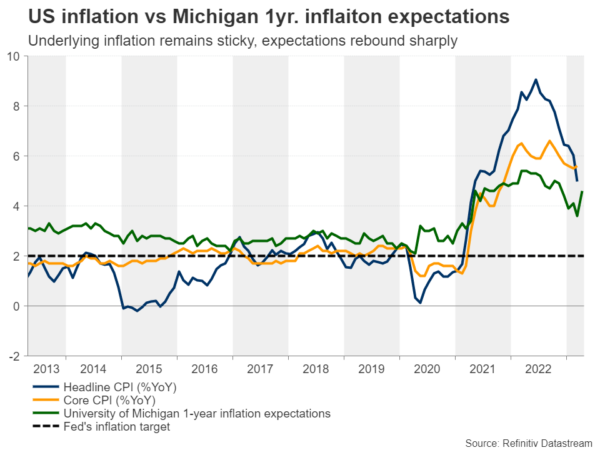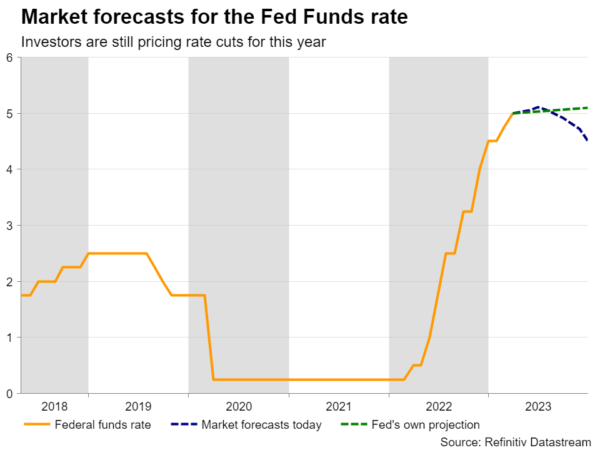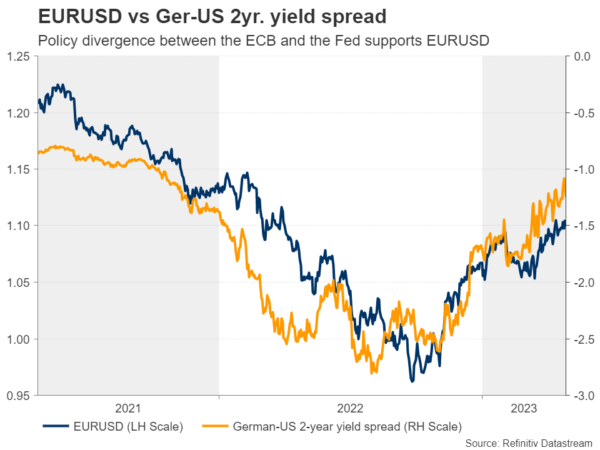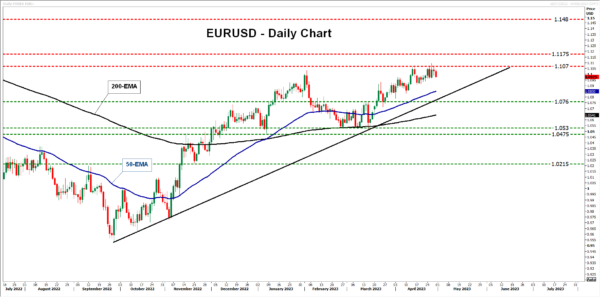On Wednesday, the FOMC is widely anticipated to deliver its last rate hike for this tightening cycle. However, with inflation staying well above the Committee’s target and underlying price pressures proving stickier than expected, will policymakers feel comfortable to signal that they are done? Or will they keep the door to more hikes open? And how may the dollar react?
Investors don’t listen to the Fed
At the last FOMC gathering, Fed officials delivered another 25bps hike, but due to the turbulence in the banking sector, they changed their forward guidance, with the change being interpreted as putting on the table the case of a pause as early as at the upcoming gathering, despite the new dot plot still pointing to a median rate of 5.1% for 2023. Investors also continued pricing in rate cuts later this year, although Fed Chair Powell pushed back against such a case. It was once again confirmed that investors do not put much trust in policymakers’ words and instead, they prefer to pay more attention to data.
Inflation is still high
Headline inflation in the US slowed by a full percentage point to 5.0% year-over-year in March, but the core rate ticked up to 5.6% y/y from 5.5%. On top of that, business surveys for April showed that overall output prices rose at their fastest pace for seven months, while the Michigan 1-year inflation expectations index rebounded strongly in April to 4.6% y/y from 3.6%.
In terms of economic growth, Thursday’s preliminary GDP data revealed that the US economy slowed to 1.1% quarter-over-quarter in Q1 from 2.6% in the last quarter of 2022. But it was also revealed that core PCE prices accelerated by more than expected in quarterly terms.
With all that in mind, investors are now nearly certain that another quarter-point hike will be delivered on Wednesday. However, they also believe that this will be the last rate increase in this tightening crusade and that the Fed will start cutting later this year. Currently, they are pricing in more than 50bps worth of rate reductions by the end of 2023.
Will this be the last hike?
Therefore, a 25bps hike will probably come as a surprise to no one. Given that this will be one of the smaller meetings, with no updated economic projections, investors may focus on the statement’s language and Fed Chair Powell’s press conference for hints about whether this was indeed the last push of the hike button and clues on how officials are planning to move forwards.
Bearing in mind that underlying inflation remains sticky well above the Committee’s 2% objective and that inflation expectations have started to rebound, it seems a very unwise choice for Powell to dismiss the likelihood of future hikes. For that same reason, he is also very likely to push back against rate cut bets again. However, the big question is whether the market will now believe him.
Dollar could gain but reversal case remains premature
Yes, the dollar could strengthen should officials leave the door open to another hike in June. However, calling for a bullish reversal may be premature. If investors remain convinced that the Fed might be forced to start cutting rates later this year, any decision-related gains could be given back very soon, especially if the ECB continues to sing the same well known hawkish song that calls for more hikes. Dollar traders may want to see evidence that the US economy has gathered more momentum before they initiate bigger long positions.
Euro/dollar is still in an uptrend
Euro/dollar has been finding it hard to clearly break above the 1.1070 resistance, which means that sellers may be willing to enter the action from near that zone should the Fed keep the chances of another quarter-point hike alive. However, the pair continues to trade above the uptrend line drawn from the low of September 28, which keeps the prevailing uptrend intact.
Any Fed-related declines could still trigger new buy orders near the trendline, with a potential rebound aiming for another test at 1.1070. If the bulls manage to overcome that barrier this time around, their next obstacle may be the 1.1175 level, marked by the highs of March 30 and 31, 2022.
For the outlook to turn bearish, a clear dip below 1.0475 may be needed. Euro/dollar would already be below the aforementioned uptrend line, while the break below that key support would confirm a lower low on bigger timeframes.
















